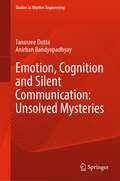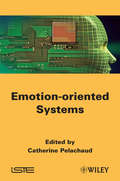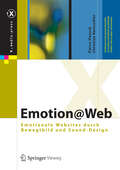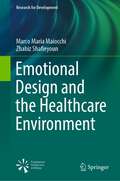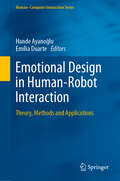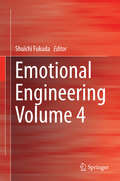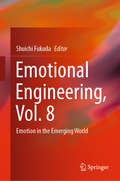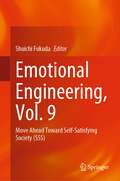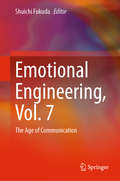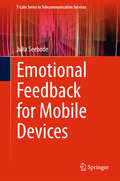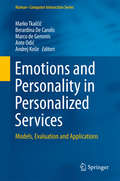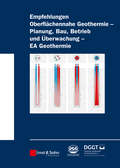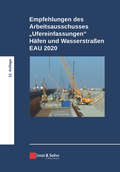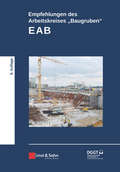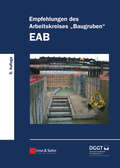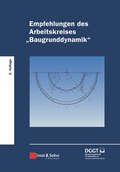- Table View
- List View
Emotion in the Design Process: Intrinsic Factors on Emotion Management for Decision-making (Design, Emotion and Creativity)
by Amic G. HoManipulating the design process can be a stressful learning experience and it can be difficult to decide how to resolve design problems. This book explores and illustrates the close relationship between emotion and the design process by using new models and perspectives under the umbrella of ‘design and emotion’. This book reveals that a greater understanding of design and emotion can inspire design students to explore how emotion can affect their decision-making and design processes. It enables the reader to develop methods to control their emotions to make effective decisions and strengthen their ability to manipulate the design process. Emotion in the Design Process features a study that develops a design process model to make the decision-making processes more transparent. With a focus on the investigation of the ‘intrinsic factors’, this book features quantitative and qualitative research methods. Underpinned by deep-level research, the book outlines the strengths and limitations of the study and reveals the findings to create decision-making models where emotion is considered. Case studies are included to show the theories in practice. By reading this book, design students, who can be confused by the design process, will be able to grasp it and learn to regulate their emotions as a result whilst also producing better designers that can improve the overall quality and standard of the design industry. As such, this book will appeal most to students, researchers and academics in any field where design is a key task. It will also be of interest to anyone interested in Design and Emotion, Kansei Design and Engineering and Design and Technology.
Emotion, Cognition and Silent Communication: Unsolved Mysteries (Studies in Rhythm Engineering)
by Anirban Bandyopadhyay Tanusree DuttaThis book provides an answer to the readers about scientific perspective on learning. It presents a culminating point of four different kinds of studies designed to measure and understand the nuances of brain functioning. The objective of this book is to find answers to four questions: (1) can there be a neuroscientific understanding of the concept of individual differences? (2) does rhythmic sound or noise have an impact on decision making? (3) how does transfer of learning between the hemispheres facilitate the learning process? and lastly (4) beyond the accepted ways of communicating verbally and non-verbally is silent communication possible? This book makes an attempt to address these issues through various aspects of inner-conscious engineering.
Emotion-Oriented Systems: The Humaine Handbook (Cognitive Technologies Ser.)
by Catherine PelachaudThe Affective Computing domain, term coined by Rosalind Picard in 1997, gathers several scientific areas such as computer science, cognitive science, psychology, design and art. The humane-machine interaction systems are no longer solely fast and efficient. They aim to offer to users affective experiences: user’s affective state is detected and considered within the interaction; the system displays affective state; it can reason about their implication to achieve a task or resolve a problem. In this book, we have chosen to cover various domains of research in emotion-oriented systems. Our aim is also to highlight the importance to base the computational model on theoretical foundations and on natural data.
Emotion@Web
by Christian Rentschler Pierre HanschBranchenübergreifend ist eine Verlagerung von den klassischen Medien hin zur digitalen Markenführung zu beobachten. Ziel ist es, effektiver, messbarer und emotionaler zu werben. Das Buch behandelt erstmalig alle Aspekte eines emotionalisierten Webauftritts - von der Konzeption bis zur Umsetzung. Dabei setzten sich die Autoren auf theoretischer wie praktischer Ebene mit auditiven und visuellen Fragen auseinander. Der Band ist zugleich Leitfaden und Nachschlagewerk, eine begleitende Website bietet weiterführende Informationen und Beispiele.
Emotional Artificial Intelligence and Metaverse (Studies in Computational Intelligence #1067)
by Roger LeeThis edited book presents scientific results of the 1st ACIS International Symposium on Emotional Artificial Intelligence & Metaverse (EAIM) which was held on August 4-6, 2022, in Danang, Vietnam. The aim of this symposium was to bring together researchers and scientists, businessmen and entrepreneurs, teachers, engineers, computer users, and students to discuss the numerous fields of computer science and to share their experiences and exchange new ideas and information in a meaningful way. All aspects (theory, applications, and tools) of emotional artificial intelligence and metaverse, the practical challenges encountered along the way, and the solutions adopted to solve them are all explored here in the results of the articles featured in this book. The symposium organizers selected the best papers from those papers accepted for presentation at the symposium. The papers were chosen based on review scores submitted by members of the program committee and underwent further rigorous rounds of review. From this second round of review, 15 of the symposium’s most promising papers are then published in this Springer (SCI) book and not the symposium proceedings. We impatiently await the important contributions that we know these authors will bring to the field of emotional artificial intelligence and metaverse.
Emotional Design and the Healthcare Environment (Research for Development)
by Marco Maria Maiocchi Zhabiz ShafieyounFor all of the tremendous advances in medicine and treatment the world has seen in the modern era, the human body’s ability to heal itself remains a (literally) vital and often overlooked facet of healthcare. Through the use of emotional design, aimed at transforming healthcare environments, such as waiting rooms, in such a way as to boost the emotional wellbeing of patients, and thus their general attitudes, including in regard to their own healing processes, medical institutions can improve outcomes for the people they treat while simultaneously lowering overall costs. Design, as an inherently transdisciplinary, problem-solving activity, is well-suited to this task. And when combined with a field of study such as neuroscience, which can literally map out the perceptions that lead to the experience of particular emotions, healthcare environments can be transformed into spaces (through such innovations as Kansei engineering) that then subsequently transform the people who rely on them the most, leading to more efficiency and less red ink.
Emotional Design in Human-Robot Interaction: Theory, Methods and Applications (Human–Computer Interaction Series)
by Hande Ayanoğlu Emília DuarteWhile social robots participation increases in everyday human life, their presence in diverse contexts and situations is expected. At the same point, users tend to become more demanding regarding their roles, abilities, behaviour and appearance. Thus, designers and developers are confronted with the need to design more sophisticated robots that can produce such a positive reaction from users so as to become well accepted in various cases of use. Like this, Human-Robot Interaction has become a developing area. Emotions are an important part in human life, since they mediate the interaction with other humans, entities and/or products. In recent years, there has been an increase in the importance of emotions applied to the design field, giving rise to the so-called Emotional Design area. In the case of Human-Robot Interaction, the emotional design can help to elicit (e.g., pleasurable) or prevent (e.g., unpleasant) emotional/affective reactions/responses. This book gives a practical introduction to emotional design in human-robot interaction and supports designers with knowledge and research tools to help them take design decisions based on a User-Centred Design approach. It should also be useful to people interested in design processes, even if not directly related to the design of social robots but, instead, to other technology-based artefacts. The text is meant as a reference source with practical guidelines and advice for design issues.
Emotional Design: Why We Love (or Hate) Everyday Things
by Donald A. NormanDid you ever wonder why cheap wine tastes better in fancy glasses? Why sales of Macintosh computers soared when Apple introduced the colorful iMac? New research on emotion and cognition has shown that attractive things really do work better, as Donald Norman amply demonstrates in this fascinating book, which has garnered acclaim everywhere from Scientific American to The New Yorker. Emotional Design articulates the profound influence of the feelings that objects evoke, from our willingness to spend thousands of dollars on Gucci bags and Rolex watches, to the impact of emotion on the everyday objects of tomorrow. Norman draws on a wealth of examples and the latest scientific insights to present a bold exploration of the objects in our everyday world. Emotional Design will appeal not only to designers and manufacturers but also to managers, psychologists, and general readers who love to think about their stuff.
Emotional Engineering (Vol #3)
by Shuichi FukudaThis book examines how theories of human emotion can be applied to engineering in order to improve product design and value. 'Emotional Engineering Vol. 3' establishes the idea that customer satisfaction can be maximised by using knowledge and experience in a more flexible manner to respond to a fast-changing world. This integration of emotion and knowledge introduces the reader to the concept of Wisdom Engineering. It also highlights the importance of emotion in creating value for the customer, and how this can be achieved by acknowledging a customer's creativity and by facilitating the customization of products for their needs and preferences. As has been identified by neuroscientists, emotion and reason are strongly interconnected, and the increasing complexities and diversification found in the products we use demonstrates the growing significance of emotion when designing these products. Society is comprised of humans and artificial products; their integration is important when considering product design, and improving quality-of-life for the customer. 'Emotional Engineering Vol. 3' builds on Dr Fukuda's previous books, 'Emotional Engineering' and 'Emotional Engineering Vol. 2', and is intended for researchers and professionals in engineering, psychology, management of technology, economics.
Emotional Engineering Volume 4
by Shuichi FukudaThis book describes the important role of emotion in a hyper-connected society and how product development and manufacture change. It explores how our work and lifestyle may be affected by forthcoming technologies and presents key research on multisensory informatics, one of the most important tools for making the most of emotion. This fourth volume of the Emotional Engineering Series focuses on the human issues relating to Cyber Physical Systems, or Industrie 4. 0, and discusses the important role emotion plays in these smart environments. Introducing related works in the field of multisensory research, which provide the basic tools for becoming context- and situation aware in this imminent revolutionary society, it discusses not only the changes in production and product development this new revolution will bring about, but also highlights how emotion plays a crucial role in making us happy in such a connected society and in bringing about harmonization between human and human, between human and machine and, last but not least, in maintaining a good work-life balance.
Emotional Engineering vol. 2
by Shuichi FukudaIn an age of increasing complexity, diversification and change, customers expect services that cater to their needs and to their tastes. Emotional Engineering vol 2. describes how their expectations can be satisfied and managed throughout the product life cycle, if producers focus their attention more on emotion. Emotional engineering provides the means to integrate products to create a new social framework and develops services beyond product realization to create of value across a full lifetime. 14 chapters cover a wide range of topics that can be applied to product, process and industry development, with special attention paid to the increasing importance of sensing in the age of extensive and frequent changes, including: Multisensory stimulation and user experience Physiological measurement Tactile sensation Emotional quality management Mental model Kansei engineering. Emotional Engineering vol 2 builds on Dr Fukuda's previous book, Emotional Engineering, and provides readers with a holistic view of its research and applications, enabling them to make strategic decisions on how they can go further beyond product realization. It is recommended for all pioneers in industry, academia and government, who are making tremendous efforts to work with their customers to create value.
Emotional Engineering, Vol. 8: Emotion in the Emerging World
by Shuichi FukudaThis book is focused on the importance of detecting people’s motivation, how they make decisions and the way the actions they take is rapidly increasing with the progress of IoT and the Connected Society. It explores how emotion-related processes are increasing in importance rapidly. The contributors move through a variety of related topics, all aimed at revealing how humans and things must increasingly interact. It indicates how strategy becomes increasingly important, particularly creating the best adaptable strategy to respond to the quickly and extensively changing situations. With engineering quickly moving from product development to experience development, and the role of emotion in engineering becoming increasingly apparent, this book offers a timely and valuable resource for engineers and researchers alike.
Emotional Engineering, Vol. 9: Move Ahead Toward Self-Satisfying Society (SSS)
by Shuichi FukudaThis is the latest volume in the series of Springer titles on emotional engineering tracking the development of this field.Engineering has been based on the Euclidean space approach and it was numerical data-centric. In short, our engineering up to now has been control-based, i.e., on tactics and problem solving. When we realize AI consumes 10,000 times more energy than human brain, we understand how it is better to use 10,000 people’s minds. But current society is industrial society. The industrial revolution introduced division of labour and we started to work for others. But the tremendous consumption of energy indicates that we need to move toward another society. If we can make the next society a self-Satisfying society (SSS) and create a new sustainable society with greater mental wellbeing then many emerging problems will be solved and we can enjoy our lives better. Emotional engineering engages with this challenge.
Emotional Engineering, Vol.10: Emotional Engineering as a Culture for 22nd Century Civilisation
by Shuichi FukudaThis book is the latest volume in the series of Springer titles on emotional engineering, tracking the development of this field. In our society, "Culture" emerges at the dawn of each era, laying the foundation for the development of "Civilization," which is then passed on to the succeeding era. "Culture" embodies the timeless essence of human characteristics, transcending temporal and spatial boundaries, encompassing the visionary pursuit of the future and the relentless quest for self-realization. Both "Motivation" and "Emotion" stem from the Latin word Movere, denoting movement. Why do we, as living beings, bear the epithet "Creatures"? It is because we instigate movement to thrive. Unlike other animals, who move merely to subsist in the present, humans navigate life with an eye toward tomorrow. "Emotion” etymologically signifies "to move out" in Latin, implying the act of manifesting one's inner realm in the external world. However, as denoted by the term "VUCA" (Volatility, Uncertainty, Complexity, and Ambiguity, our society is rapidly evolving into a realm of increasing complexity and diversity, transitioning from the tangible to the intangible. While the tangible realm necessitates interaction, the evolving landscape calls for the intervention of technology. Technology delves into the realm of "How." Yet, "Culture" resides in the emotional domain, pondering "What" and "Why,", as does Engineering. The "Process" of daring to transform dreams into reality assumes paramount significance. History admonishes us that now is the opportune moment to forge a novel "Civilization" for the twenty-second century. Let us harness the power of Emotional Engineering to sculpt the twenty-second century "Civilization" into its best iteration. This book of collected chapters sums up this challenge and how we can meet it.
Emotional Engineering, Vol.5
by Shuichi FukudaThis book provides a review of the latest research on emotion in engineering, with a particular focus on design and manufacturing. Topics include experience, happiness, cognitive science, neuroscience, additive manufacturing, universal design, branding, teamwork. Throughout the book, the emotions of the end users of engineering products are discussed, as well as the perspective of the expert. The book provides researchers, students, and practicing engineers with an opportunity to examine research and practice in engineering from a different perspective, and offers pointers to how to collaborate with people from other fields to help achieve a more connected society.
Emotional Engineering, Vol.7: The Age of Communication
by Shuichi FukudaThis book demonstrates that emotion is a highly influential component in creating a new society and new engineering, revealing the importance of emotion in various aspects of the Connected World. It addresses a wide variety of topics, but with this one underlying aim throughout. Further, it stands out for the approach it takes to the Internet of Things and the Connected Society. The contributing authors illustrate that humans are essentially either playmakers or playing managers, with teamwork and play being crucial aspects of our lives. They argue that strategy is becoming increasingly important, and consider the most adaptable strategy, one that will allow us to respond to today’s quickly and radically changing situations. The book is particularly focused on the Connected Society as the point of departure, and explores what motivates humans, what decisions they should make, and what actions they should take. With engineering quickly moving from product development to experience development, and the role of emotion in engineering becoming increasingly apparent, this book offers a timely and valuable resource for engineers and researchers alike.
Emotional Feedback for Mobile Devices
by Julia SeebodeThis book investigates the functional adequacy as well as the affective impression made by feedback messages on mobile devices. It presents an easily adoptable experimental setup to examine context effects on various feedback messages and applies it to auditory, tactile and auditory-tactile feedback messages. This approach provides insights into the relationship between the affective impression and functional applicability of these messages as well as an understanding of the influence of unimodal components on the perception of multimodal feedback messages. The developed paradigm can also be extended to investigate other aspects of context and used to investigate feedback messages in modalities other than those presented. The book uses questionnaires implemented on a Smartphone, which can easily be adopted for field studies to broaden the scope even wider. Finally, the book offers guidelines for the design of system feedback.
Emotional Intelligence and Neuro-Linguistic Programming: New Insights for Managers and Engineers (Manufacturing Design and Technology)
The development of a new book about Emotional Intelligence (EI) and Neuro-Linguistic Programming (NLP) and the challenges to managers and engineers is essential because it introduces new lines of research in management and production. The use of EI and NLP allows management to take a more strategic role in organisations. There is a growing importance of sophisticated analysis for managers to support decision making, to use emotional information in order to guide thinking and behaviour, as well as to manage emotions to adapt environments and achieve the organisation's goals. This book addresses several dimensions of EI and NLP and its impact in business and organisation competitiveness. Features Focuses on the latest research findings that are occurring in this field all over the world Shows in what ways companies around the world are facing today's EI and NLP challenges Presents knowledge and insights on an international scale Assists researchers and practitioners in selecting among the different options and strategies, the more relevant priorities to managing competitive organisations Offers the latest developments in the field and of forthcoming international studies
Emotions and Personality in Personalized Services
by Marko Tkalčič Berardina De Carolis Marco De Gemmis Ante Odić Andrej KoširPersonalization is ubiquitous from search engines to online-shopping websites helping us find content more efficiently and this book focuses on the key developments that are shaping our daily online experiences. With advances in the detection of end users' emotions, personality, sentiment and social signals, researchers and practitioners now have the tools to build a new generation of personalized systems that will really understand the user's state and deliver the right content. With leading experts from a vast array of domains from user modeling, mobile sensing and information retrieval to artificial intelligence, human-computer interaction (HCI) social computing and psychology, a broad spectrum of topics are covered. From discussing psychological theoretical models and exploring state-of-the-art methods for acquiring emotions and personality in an unobtrusive way, as well as describing how these concepts can be used to improve various aspects of the personalization process and chapters that discuss evaluation and privacy issues. Emotions and Personality in Personalized Systems will help aid researchers and practitioners develop and evaluate user-centric personalization systems that take into account the factors that have a tremendous impact on our decision-making - emotions and personality.
Emotions, Technology, and Digital Games (Emotions and Technology)
by Sharon Tettegah Wen-Hao HuangEmotions, Technology, and Digital Games explores the need for people to experience enjoyment, excitement, anxiety, anger, frustration, and many other emotions. The book provides essential information on why it is necessary to have a greater understanding of the power these emotions have on players, and how they affect players during, and after, a game. <p><p> This book takes this understanding and shows how it can be used in practical ways, including the design of video games for teaching and learning, creating tools to measure social and emotional development of children, determining how empathy-related thought processes affect ethical decision-making, and examining how the fictional world of game play can influence and shape real-life experiences. <p><p> • Details how games affect emotions—both during and after play <p>• Describes how we can manage a player’s affective reactions <p>• Applies the emotional affect to making games more immersive <p>• Examines game-based learning and education <p>• Identifies which components of online games support socio-emotional development <p>• Discusses the impact of game-based emotions beyond the context of games
Empfehlung Oberflächennahe Geothermie: Planung, Bau, Betrieb und Überwachung - EA Geothermie
by AaaThe aim of the Recommendations is the technically correct exploitation of the subsoil for geothermal purposes. It should be of assistance in avoiding impairment of soil and groundwater during the operation of the plant and buildings.
Empfehlungen des Arbeitsausschusses "Ufereinfassungen" Häfen und Wasserstraßen EAU 2020
by HTGDie 12. Auflage der "EAU 2020" beinhaltet eine inhaltliche Straffung und Neustrukturierung der Empfehlungen mit dem Ziel einer verbesserten und verständlicheren Kapitelstruktur. Außerdem wurden die seit dem Erscheinen der 11. Ausgabe der Empfehlungen des Arbeitsausschusses "Ufereinfassungen" veröffentlichten Technischen Jahresberichte in die Empfehlungen eingearbeitet. Die Empfehlungen berücksichtigen weiterhin die neue Normengeneration, bestehend aus Eurocode 7, zugehörigen nationalen Anwendungsdokumenten und ergänzenden nationalen Regelungen (DIN 1054:2010). In Einzelfällen werden Teilsicherheitsbeiwerte aufgrund von Praxiserfahrungen abweichend festgelegt. Der Sicherheitsstandard der See- und Hafenbauwerke bleibt somit erhalten, die Empfehlungen genügen weiterhin dem Anspruch auf internationale Anerkennung und Anwendung bei Planung, Entwurf, Ausschreibung, Vergabe, Baudurchführung und Überwachung sowie bei Abnahme und Abrechnung von Hafen- und Wasserstraßenanlagen nach einheitlichen Gesichtspunkten.
Empfehlungen des Arbeitskreises "Baugruben" (EAB)
by Deutschen Gesellschaft für Geotechnik e. V.Mit der Herausgabe der Empfehlungen, die normenähnlichen Charakter haben, unterstützt der Arbeitskreis "Baugruben" der Deutschen Gesellschaft für Geotechnik e.V. (DGGT) die Planungspraxis bei Entwurf und Berechnung von Baugrubenumschließungen. Alle Empfehlungen wurden gegenüber der vorherigen 5. Auflage gründlich überprüft, soweit erforderlich überarbeitet und an neue Erkenntnisse angepasst. Wesentlich geändert wurden die Erfahrungswerte für Mantelreibung und Spitzendruck von Spundwänden und Trägerbohlwänden. Das Kapitel "Baugruben in weichen Böden" konnte erheblich gestrafft werden. Einem dringenden Bedürfnis der Praxis folgend wurde zudem ein völlig neues Kapitel "Unterfangungen" als Baugrubensicherung erarbeitet. Die Empfehlungen des Arbeitskreises "Baugruben" sollen helfen, - Entwurf und Berechnung von Baugrubenumschließungen zu erleichtern, - Lastansätze und Berechnungsverfahren zu vereinheitlichen, - die Standsicherheit der Baugrubenkonstruktionen und ihrer Einzelteile sicherzustellen und - die Wirtschaftlichkeit der Baugrubenkonstruktionen zu verbessern.
Empfehlungen des Arbeitskreises "Baugruben" (EAB)
by EabMit der Herausgabe der Empfehlungen, die normenähnlichen Charakter haben, unterstützt der Arbeitskreis „Baugruben“ der Deutschen Gesellschaft für Geotechnik e.V. (DGGT) die Planungspraxis bei Entwurf und Berechnung von Baugrubenumschließungen. Zur bauaufsichtlichen Einführung der Eurocodes wurde eine Anpassung der 4. Aufl age der Empfehlungen an die Vorgaben der DIN EN 1997-1:2009 in Verbindung mit dem Nationalen Anhang DIN 1997-1/NA:2010-12 und den ergänzenden Regelungen der DIN 1054:2010-12 erforderlich. Alle Empfehlungen wurden gründlich überprüft, soweit erforderlich überarbeitet und an neue Erkenntnisse angepasst. Wesentlich überarbeitet wurde Kapitel 10 „Baugruben im Wasser“. Aufgrund der fortgeschrittenen Entwicklung in der Messtechnik und den gestiegenen Anforderungen wurde Kapitel 14 „Messtechnische Überprüfung und Überwachung von Baugrubenkonstruktionen“ völlig neu formuliert. Die Empfehlungen des Arbeitskreises „Baugruben“ sollen helfen, • Entwurf und Berechnung von Baugrubenumschließungen zu erleichtern, • Lastansätze und Berechnungsverfahren zu vereinheitlichen, • die Standsicherheit der Baugrubenkonstruktionen und ihrer Einzelteile sicherzustellen und • die Wirtschaftlichkeit der Baugrubenkonstruktionen zu verbessern.
Empfehlungen des Arbeitskreises "Baugrunddynamik"
by Deutschen Gesellschaft Füx Geotechnik E. V.Die in dem Sammelband "Empfehlungen des Arbeitskreises 1.4 Baugrunddynamik" der Deutschen Gesellschaft für Geotechnik e.V. (DGGT) zusammengefassten Empfehlungen haben das Ziel, das Vorgehen bei baugrunddynamischen Aufgaben zu vereinheitlichen. Ferner geben Sie Hinweise, wie durch angemessene baugrunddynamische Untersuchungen die Beeinträchtigung von Einrichtungen, Schäden an Bauwerken und Anlagen sowie störende Umwelteinwirkungen auf Menschen und Geräte vermieden werden können. Die vorliegenden Empfehlungen stellen den neuesten Stand von Wissenschaft und Technik auf dem Gebiet der Baugrunddynamik dar. Sie beruhen auf gesicherten Erkenntnissen, die einen empirischen Nachweis einschließen, d. h. es liegen für diese Empfehlungen auch praktische Erprobungen vor. Sie sind daher Bestandteil der "allgemein anerkannten Regeln der Technik". Für die vorliegende zweite Ausgabe wurden die Empfehlungen erneut umfangreich überarbeitet und um zwei Teile ergänzt.

